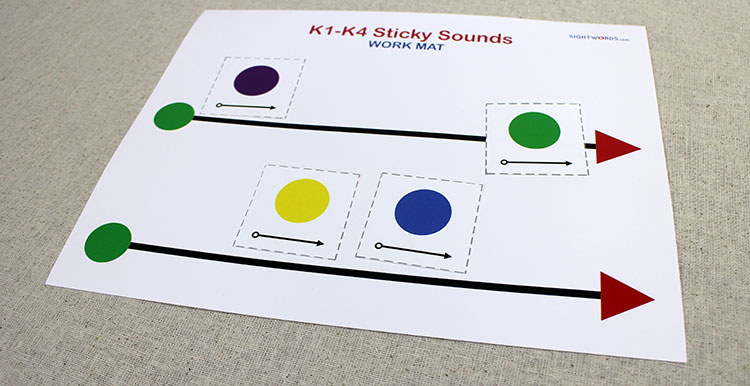K4: Separating More Sticky Sounds
1. Overview
Remove the first consonant from a four-sound word with an initial consonant blend to create a new word. This game focuses on removing the first sound from a consonant blend at the beginning of a four-sound word in order to make a three-sound word. It is the exact opposite of More Sticky Sounds.
K4: Separating More Sticky Sounds
2. Materials
- Script
- sound counting markers — you only need four of the markers for this game
- work mat
- word list
3. Activity
Video: How to play Separating More Sticky Sounds
Start out by explaining the concept of the game to your child.
Adult: You’ve already learned about sticky sounds that like to stick together at the beginning of a word. In this game we’re going to do more practice pulling those sticky sounds apart. You will listen very carefully to the beginning sounds of a word. I’m going to remind you how to take one of the sticky sounds away from the beginning of a word to make a new, shorter word.Put the sound counting markers and the work mat in front of the child. He will use these to count the sounds in the words of this activity. Remind him that we read words from left (the green circle, as in “go”) to right (the red triangle at the end of the arrow, as in “stop”). Have him use his index finger to trace the arrow from the green circle to the red triangle.
Adult: Use these markers to show me the sounds in the word I say. Listen carefully: flip. “I did a flip on the trampoline.” Say flip. What word? Child: Flip. Adult: Yes. Say the sounds in flip, and put a marker on the mat for each sound you say. Start here. [Point to green circle on the top arrow.] Child: /fff/ [places 1st marker] … /lll/ [2nd marker] … /iii/ [3rd marker] … /p/ [4th marker] Adult: Good job. You placed the sound markers in just the right order to make the word flip.Now tell the child how to count the sounds in a second word by putting sound counting markers on the bottom arrow of the work mat.
Adult: I’m going to say another word, and you’re going to count the sounds again. If you hear a sound that you already used to make the word flip, move that sound marker down from that word. What was the first word? Child: Flip. Adult: Yes. Here’s my new word. Listen: lip. “When I pout, I stick out my lip.” What word? Child: Lip. Adult: Now say all the sounds in lip and put them in the order that you say them on the mat. Remember, if you need a sound marker that you already used for a sound in flip, pick up the marker from the top arrow and move it to the right place on the bottom arrow. Child: /lll/ … I used that in flip, so I move this marker down here. And /iii/ … that was in flip too! Adult: Did you use the /p-p-p/ marker for one of the sounds in flip? Child: Yes. So I have to move that marker down to the bottom arrow. Adult: Good. Now say the sounds in your new word, lip, quickly. Start here. [Point to green circle on bottom arrow.] Child: l/i/p. Adult: What sound in flip did you not use to make lip? Child: /fff/ Adult: That’s right. /fff/ and /lll/ are sticky sounds in the word flip, but you pulled them apart and cut off the /fff/ sound to make the word lip!Once your child has successfully completed one round of the game, have him remove the sound counting markers from the mat before starting the next round. One session of this game should last 10-15 minutes, with you and your child covering 6-8 word pairs. Repeat these word pairs several times in random order within the session to give your child lots of practice. ↑ Top
4. Confidence Builder
Physically guide your child’s hand through this activity to pattern exactly what he should do. Put your hand over his, leaving his index finger free, and say the sound for each marker as you both move it. Do several rounds of the activity in this way, and then let the child try on his own. ↑ Top5. Extension
Select a word that the child is already very familiar with from previous sessions of this activity. Say the word very slowly and have him repeat it back to you. Tell him to take away the first sound and try to say the new word. This is the same as the main activity, but the absence of any visual aids (the sound counting markers and work mat) makes it more challenging. Try to use consonant blends where both consonants are continuant sounds, so that you can stretch them both out if you need to do so. For example: flag without /fff/ becomes lag; or sleep without /sss/ becomes leap. (Remember, spelling doesn’t matter.) ↑ Top6. Small Groups (2-5 children)
Lesson Objective: Using sound counting markers and a work mat, children will hear a four-sound word with a consonant blend, count and order the the four sounds, and delete the first consonant sound in order to form and orally state a new word. GELDS (Georgia Early Learning & Development Standards): CLL6.4f (closest standard) Note: This is much too difficult a skill for most Pre-Kindergarten children. Georgia Standards of Excellence: ELAGSEKRF2.e (Introduce late in the Kindergarten year.) Common Core State Standards: CCSS.ELA-LITERACY.RF.K.2.E Additional Materials:- enough work mats and sound counting markers for each child
- optional: pocket chart (for displaying work mat and counters)
Leave a Reply
